By guest blogger Beth Terry
Last fall, Rodale.com’s Dana Blinder forwarded me a cool article: Keep Your Garden Plastic-Free with These Easy Swaps. Knowing that I write the blog My Plastic-free Life, she thought the topic of gardening with less plastic might be interesting to me and to my readers. What she didn’t know was that I had already failed miserably in the gardening department several times, and wasn’t sure gardening was my thing. That’s when we came up with a brilliant idea. Rodale would teach me how to grow an organic garden, and I would figure out how to do it with the minimum plastic possible.
My guru for this project is Eric Hurlock, online editor for OrganicGardening.com. First, I sent him photos of my postage stamp–sized front yard, the only space available for a garden. (My neighborhood in Oakland, CA, is in Zone 8B, according to the USDA Hardiness Zone Finder.
I explained that the yard is basically hard clay that gets overrun every spring by tough little yellow flowers that refuse to be pulled up. Each year, the landlord sends some guys over to chop the weeds down, but they’re never uprooted. I’m betting the roots are taller than I am at this point.
Eric suggested that instead of trying to make my hard, weedy soil hospitable to vegetables, I should build a raised bed filled with rich, organic soil on top of it. Oh dear. I’m building now? I could see this project was going to be more complicated than buying a bunch of plants and sticking them in the ground. Still, I was committed. And I wanted to not only make this garden plastic free, but as low impact as possible. So I asked about using salvaged lumber for the frame of the raised bed instead of brand-new wood.
Eric said no. For an organic garden, secondhand wood would not work because it might have been treated with toxic chemicals in its previous life, and we’d have no way of knowing. So instead, I looked for new lumber certified by the Forest Stewardship Council (FSC) to be from sustainably managed forests. I rented a pickup truck from Zip Car (the car-share service I belong to so I don’t have to own a car) and scooted over to Ashby Lumber in Berkeley, which I discovered carries plenty of FSC-certified wood.
I purchased nails from the bulk bin at the hardware store, tossing the amount I needed into a brown paper bag, which I will be sure to reuse.
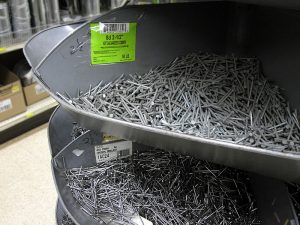 My husband Michael sawed the boards to the right length for me (My arm’s been acting up, or I would have done it myself!), and then I set to work building my 6′ x 4′ x 12″ box.
My husband Michael sawed the boards to the right length for me (My arm’s been acting up, or I would have done it myself!), and then I set to work building my 6′ x 4′ x 12″ box.
But what would I put under my box to keep the weeds from coming up through the new soil I would buy? Black plastic, popular among so many gardeners, was obviously out.
Eric suggested using cardboard instead. Perfect. We have an attic full of broken-down cardboard moving boxes. I used a few of those.
And then I had to find a way to fill the box with soil without ending up with a billion plastic bags.
Some companies, such as American Soil and Stone in Richmond, CA, sell soil and amendments in bulk. They can dump it into your own truck or deliver it to your door. Bright and early one Wednesday morning, a big truck pulled up loaded with “Local Hero Veggie Mix” (Contains: Sandy Loam, WonderGrow Organic Compost, Rice Hulls, Chicken Manure, Grape Compost, Fir Bark, Cocoa Bean Hulls) for me. “I hope you can use extra,” the driver said, “because I have way more than you ordered.”
Sure! More is always better, right? Um… not if it’s Wednesday morning and the guy dumps the dirt right in the middle of the sidewalk, and you have to shovel all of that dirt off the sidewalk before leaving for work, all the while praying someone in a wheelchair doesn’t need the sidewalk before you’re done. But I did it. I was prepared with my shovel, as well as a wheelbarrow I had borrowed from our local tool-lending library. Yep, the wheelbarrow is plastic, but according to my plastic-free rules, borrowing and sharing durable plastic goods, instead of buying new, is not only allowed, it’s encouraged.
I shoveled all morning until my shoveler was sore. And as you can see, I did end up with way more dirt than would fit in my little raised bed frame.
But it turns out that that’s good. Because Eric says that I shouldn’t plant my squash or cucumbers, which tend to spread out, in the box, but in mounds of their own outside the box. I’ll also use some of the dirt to grow herbs in terra-cotta pots. All this talk of veggies and herbs leads me to my next plastic-free dilemmas:
1: Buying plants that don’t come in plastic pots. I can plant seeds from paper envelopes, but Eric says that I should not grow tomatoes and peppers from seeds but from seedlings.
2: Finding a plastic-free garden hose. Does such a thing even exist? And if not, what’s the most ecofriendly hose I can buy? Or is there a better way to water?
3: Finding plastic-free gardening gloves. My hands were pretty calloused after all that shoveling, and my fingernails were a mess. A pair of gardening gloves would be nice, but I’m not interested in gloves made with vinyl or polyester, and I’m a vegetarian so I don’t want leather or suede, either.
Do you have advice for me? I’d love to hear it.

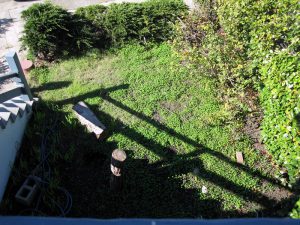
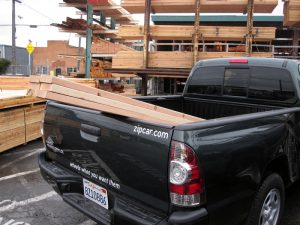
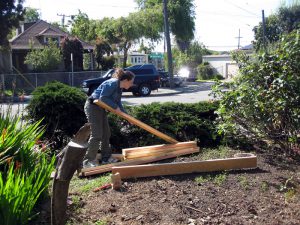
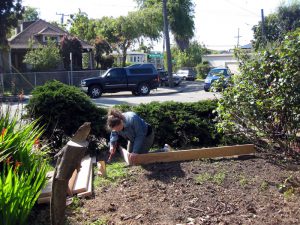
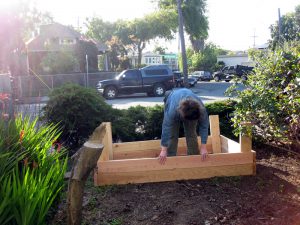
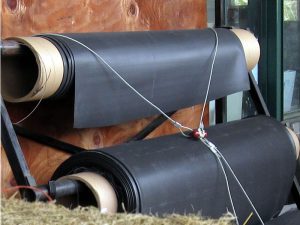
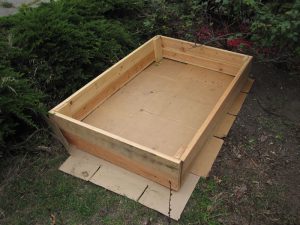
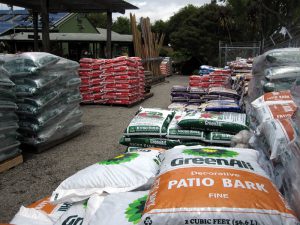
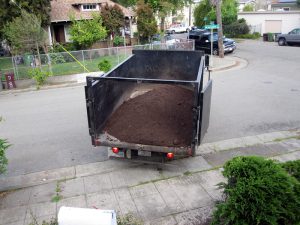
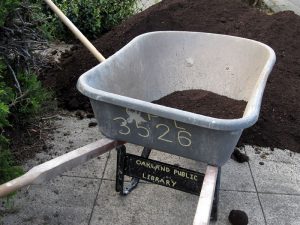
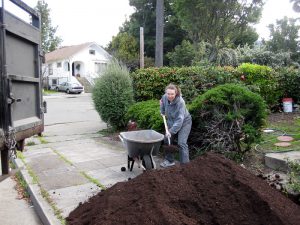
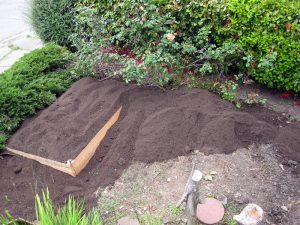



We grow all of our plants from seeds- using a metal soil block maker- no pots in paper or plastic! It is a little late to start from seed however. Check Craigslist for local folks selling started plants, or flea/farmers markets nearby if you have them.
We don’t use a hose for our beds- we use a rain water collection system to harvest water from the roof – you can make from old oak barrels. We then water the beds with a metal watering can. Last year we didn’t use a drop of “fresh” from the tap water- it was all rainwater.
Folks building raised beds in the Northwest should investigate Orcaboard – a company that uses recycled plastic to build durable, fit together boards for all sizes of beds, seats etc. These will last forever! and have no creosote or any sort of chemicals. I also order plants from High Country Gardens who pack so beautifully in tiny cardboard bits and the plants come through like champs!
MrsKrenzer – Love the rainwater idea!
Sue S – I’m excited to check out High Country Gardens. Do you know if they have plants grown from Heritage seeds or if they’re organic?
Thanks!
Hi,
Does it count it you get your seedlings from a local nursery that has been reusing plastic pots over and over? That’s where I got my tomatoes. Whole Foods had some herbs and veggies for sale in pots made from compressed plant materials (I don’t know what holds them together). But, why not start your tomatoes from seeds? I never do, but I’m rather lazy right now.
As to gloves, there is no way I’d work outside without them (and, I work outside..). I am currently using West County Gloves http://www.westcountygardener.com/ and they are made with recycled plastic. You can also get bamboo biodegradable gloves, http://www.gogreensgloves.com/ but I don’t think bamboo is a great solution. I’d say leather is your best bet but, its not vegan. Your going to need something stronger than just uncoated cotton gloves, and I can’t imagine how you could do that without leather or petroleum. When thinking of a plastic free solution I try to think “what did people do before all this plastic” which would probably be leather.
Since your garden is so small, why not bring the water to it? Or, get a used hose online. Just make sure the hose is coiled up in the shade without water in it, so the water you use on the plants is not in contact with the plastic long.
Thanks for the suggestions. I will look into High Country Gardens, for sure.
I’m having a problem avoiding plastic plant markers. Obviously, they are not an issue for plants I plant from seed. But I can’t seem to find seedlings without them. I even contacted one of the local growers to find out if they could take back the plastic markers to reuse, and they said no unfortunately, even though their pots are non-plastic.
I like the metal watering can idea. Someone else told me they use a metal bucket and ladle water onto their plants. Have you heard of that?
What is a metal soil blocker? I really an a newbie at all of this and appreciate your help!
I think when a grower gets seeds or plugs they get a bundle of plant markers along with them. At least that’s how it was at the greenhouse I worked with. I think the most you can do there is write the company (and pass it on to your readers!) that you would like a tag alternative. But I think recyclable is the best they can do. Typical shoppers like tags so they know what they are buying & can remember what they planted.
I think using a ladel might wear you out and dump too much water on a seedling. Metal watering cans are cool – just don’t be like my mom and leave water in it when there’s a freeze!
By the way, Badger Balm is a great plastic free solution to help restore your hands! Mine got all messed up from the cotton/latex gloves I was using (never dried, so my skin started peeling) so I’ve been slathering them with Badger Balm and wearing cotton gloves at night.
Well, I just got a response back from High Country Gardens. Sadly, they do use plastic. Carrie wrote: “We do actually use plastic pots for the plants. We also occasionally use bubble wrap for some of the heavier items like the fountains and birdbaths. ”
Ah well. I have found plants in my area in plastic-free pots. More on that in a future post here. 🙂
Beth,
My gloves are cotton. Pretty common and can be bought at a dollar store. You can purchase tomato and pepper plants in compost containers. I bought mine at a native gardening center.
I think I bought bee balm last year at the home depot and it came in a fiber pot – you just take the bottom off and plant it like that -I believe they have vegetables from the same vendor – though I do not think they are organic.. I hope you enjoy your garden – you are an inspiration
It might be too late in the season now, but even though I’ve *always bought pepper and tomato plants in the past, I’ve had excellent luck in the past couple of years growing mine from seed. WAY easier than I’d been led to believe.
Wooden sticks from icecream bars make good plant markers or painted rocks, sticks with or without wooden signs on them. As for tomatoes if you like cherry tomatoes they grow fast and you can plant seed or just buy a tomato and smash it in the yard it will grow just fine.
In fact every time I try to put seedlings or even seeds where I want them to grow the volunteers come up and grow way better where they want not where I want them to,
Vicky, thanks for the suggestions. Yes, popsicle sticks will work great to mark the seeds I have planted. But I am annoyed by the plastic markers that come with plants. I haven’t found plants sold without the plastic markers, and the nurseries won’t take them back to reuse.
For starting seeds from paper envelopes for next year — always planning ahead when gardening 😉 — you can use jiffy pots, which I believe have no plastic content. If not, there is a small wooden tool that you can find to form pots out of old newsapers. You can use an old metal baking pan to set the Jiffy pots in to keep the seedlings moist (kind of a self-watering seedling pot).
When you’re ready to grow more than the garden space allows, don’t forget metal baskets with coconut liners. Lots of food plants can grow in there – cherry tomatoes, peas, beans, even zucchini if the pot is big enough.
Thanks for the article – lots of food for thought!
Living and gardening without plastic products is demented. There is no reason to be so picayune.
Some plants come in jiffy pots but they may not be organic. Also, I wonder if old metal watering cans have lead in them. I just learned awhile ago there is a difference between potable and nonpotable hoses. One you can drink from and the other you can’t.
I have a sprinkler system in my garden since it is too big for hand watering. You know me, Beth. The garden that keeps getting bigger and bigger.
I wished you lived closer. I get extra tomato seedlings from my compost. You could take them. They grow right outside of it. Tomato seeds don’t die in my compost!
Nice work, except that a cardboard lining under your planter boxes will soon compost and weeds will reappear. I have a half acre garden of fruit trees, flowers, and veggies. I use no chemicals, no plastic bags, and I have rain collection from sisterns to water my beds. I do suffer through buying plants in plastic containers from local nurseries who reuse the plastic pots.
Or are we trying to eliminate plastic completely? Good luck. As Charlie Moore responded recently to his audience about plastic tooth brushes, “What’s wrong with using pig bristle?” He was joking.
Beth: This (http://www.johnnyseeds.com/p-8087-medium-4-soil-blocker-4-blocks.aspx) is a metal soil block maker. We purchased peat, sphagnum moss, etc in bulk, then mixed our own starting mix. Add some water, use this handy little tool, and voila- you have blocks of soil with no pots- paper or plastic. I can send a picture of it in use if you like… I know you don’t have much room to do this without the cats around, but if you find some- try this. It came wrapped in paper also- no plastic in shipping. I use bamboo skewers (with a wide end) for labeling my plants- they are leftover from my self-catered wedding a few years ago and seem to have a 1,000,000,000 uses… We have a garden (new this year) that is 100′ X 50′ and haven’t used any plastic thus far, except for a rain barrel that was repurposed that we’ve had a couple of years now…
Celia, as a vegetarian, I can’t bring myself to use pig bristle. But I do have a toothbrush post coming up very soon, including one pig bristle brush. I think he was only half joking.
No, Beth, he was seriously joking. Silly people in the audience were quizzing him on what to do about tooth brushes. Fight the battles we can win?
I too am a vegetarian. I thought you would appreciate my serious comments on gardening. Definition of a weed: a plant we don’t welcome in our garden. My lawn is no more; rock garden, raised beds, fruit trees, natural whatever. I enjoy pulling weeds, it’s therapeutic. Some I leave for the bunnies.
How do you get around the fact that most tools have plastic handles, I don’t want to buy tools again and wooden ones cost a small fortune and break to easy.
A good many valbuales you’ve given me.
I wasn’t aware people ate their toothbrushes or gloves, how does this relate to being a vegetarian.
First, the potted plants- Bonnie plants usually come in a coconut fiber pot if you get the smaller plants.
Second, a garden hose that is not plastic is near impossible to find. There are some soaker hoses that are made from tightly woven fabric, but that’s really not what you need. I have seen a few hoses that are for camping and recreation that are bpa free plastic, so it is safe to drink from and I believe they are from recycled materials. Natural rubber is impossible to find simply because it will not last when exposed to the elements. You could always consider looking into a rain barrel that will sit in the middle of you garden. You can make compost tea in it, and dip the water out for the individual plants.
Tool Library?!?!?! That’s amazing! I want one!
As for the plastic pots I think that if you are sure to buy them from a place that recycles them and uses them again that’s the closest you’re going to get. I’ve purchased some plants that are in biodegradable peat pots but they weren’t organic…unfortunately I’ve never seen them both ways 🙁